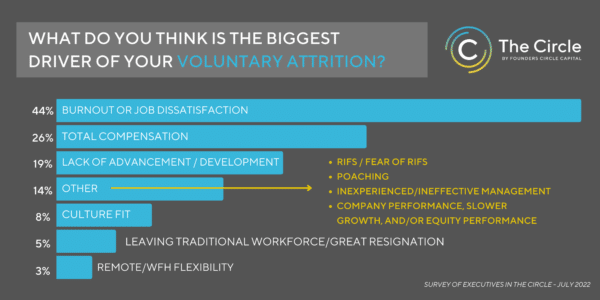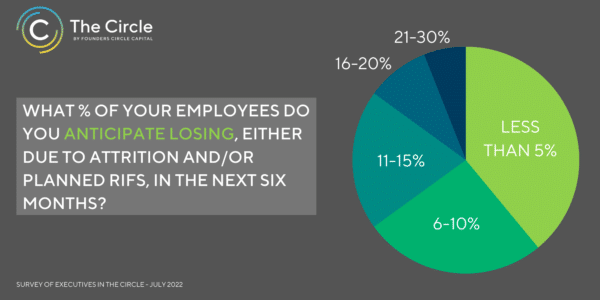Trending
Top CFO Tactics for Reducing Software Spend & Consolidating Systems
/in I'm Looking for Strategic Planning Tips, Software Stack for Growth Companies, Systems & Processes, Trending, Featured on Home/by Matt McCue4 Considerations To Craft Your Company’s Equity Strategy
/in I Need to Retain my Top Performers, Secondary Liquidity, Developing Your Team, Talent, Trending, Equity & Compensation, Featured on Home/by Matt McCueAdvancing Your Influence: Strategies for CFOs
/in CFO Leadership, Leadership & Vision, Developing Your Team, Talent, Trending, Featured on Home/by Matt McCueShare this entry

Retaining Employees Through Uncertain Market Conditions
Strategies for curbing attrition, building trust, and upskilling talent
Retaining strong talent is critical to the health and success of any company, especially during periods of uncertainty. As finance and people leaders shore up talent and resources amidst market turmoil, many are looking for strategies to combat voluntary attrition and keep their best people engaged and satisfied.
We invited two experienced people leaders – Beth Steinberg (Chief People Person @ Chime) and Michele Bousquet (Chief People Officer @ Strava) – to help leaders in The Circle unpack the real reasons why employees choose to stay or leave.
Here are the key takeaways from the discussion:
What is Driving Voluntary Attrition in 2022?
Burnout, compensation, and a lack of advancement opportunities were the top three biggest drivers of voluntary attrition cited in our poll of CFOs and CHROs in The Circle.


“Employee burnout is very real right now,” said Michele Bousquet. Between a global pandemic, a shift to remote and hybrid work, rising political and social tensions, and new challenges for parents in the workplace, a lot is impacting the psyche of employees. As a result, millions have already left their jobs in The Great Resignation, while many that remain are straddling the fence, feeling unsatisfied about their job yet paralyzed by economic uncertainty (a trend Michele nicknamed “The Great Freeze”).
Further complicating retention is the fact that, over the last two years, employees have had greater job optionality; therefore, the balance of power has shifted to employees and put pressure on companies to meet their increasing demands (or let them walk). For employers, now is the time to think hard about whom they want to keep and let go.
“It’s important to retain people who want to be at your company; otherwise, there will be a drag on productivity and the company culture. Identify the employees that are high-performers and excited about the company, and spend time learning what’s driving their behaviors or potential attrition risks.” – Michele Bousquet, Chief People Officer at Strava
Be Proactive, Not Just Reactive
Retention often comes under the microscope after it has become a significant issue when it can sometimes be too late to address the underlying drivers meaningfully. It pays to invest time and attention into the cultural elements that can have a major impact on employee decisions to stay or go, such as:
- Setting High Performance Standards – Employees, especially high-performers, need to know that good work is rewarded and underperformance doesn’t go unnoticed. Creating and staying accountable to a high-performance work culture motivates employees to do their best work and assures them they are working alongside other capable people.
- Creating a More Inclusive Culture – “I think companies make the mistake of deprioritizing DEI initiatives in uncertain times,” said Michele. “But more than ever, employees, especially Gen Z, want to see that leaders are embracing equity and inclusion and not regressing back to the traditional culture of work.”
- Investing in Employee Engagement – Now might be a good time to invest in people management software and programs that help you engage employees and harness their feedback on a deeper level. Solutions like SeekOut and Lattice can provide a more holistic view of your internal and external talent pipeline. CultureAmp and AllVoices can help you measure and analyze employee sentiment at scale.
Communicate and Solicit Employee Feedback
In times of uncertainty, employees are watching leaders very closely and every interaction is an opportunity to earn or erode trust. To get a better understanding of the underlying frustrations and issues impacting employee dissatisfaction, leaders have to use every available avenue to solicit and address that feedback.
“It’s essential to show your employees that you’re not only listening, but also addressing their concerns. The issues aren’t always cultural – sometimes, spans of control are hindering productivity or there’s lack of clarity around roles and responsibilities. Dig in and start listening to people to make sure they always know they’re valued.” -Beth Steinberg, Chief People Person at Chime
Company-wide surveys and individual conversations are effective tools for getting a pulse on employee sentiment; however, your front-line managers are the ones engaging employees on a daily basis. It is important to equip those managers with the skills and messaging to not only address employee frustrations, but also instill confidence in the organization.
Retention Compensation
Naturally, The Circle has had a lot of conversation lately about bonus programs, location-based pay, and other compensation tactics to drive retention. Every strategy has pros and cons, but every decision should be grounded in a clear pay philosophy and defensible rationale.
“Always assume your employees will talk with each other, and compensation information will leak out,” said Michele. Be ready to face some pushback from certain employees if you run a specific compensation-focused retention effort. Still, as long as your decision-making is grounded in data and a logical strategy, you’ll be well-positioned to field employee questions and answer them confidently.
Beth added that having your CEO or CFO address the current market challenges with the entire company can provide meaningful context around compensation strategy decisions.
Upskilling and Advancement Opportunities
Everyone wants to work for a company that is going to help advance their career. Learning and Development (L&D) has become a very important retention tool, but companies must balance up-leveling emerging talent with not having too many inexperienced leaders.
To ensure leaders at every stage are ready to take the next step in their career, Beth is a strong proponent of having a talent planning process and coaching for mid-level managers and directors. “We have proven with data that these programs generate more successful leaders, and quantifying those results has allowed us to build a case for the CEO and CFO to invest more in them,” she said.
There are low- or no-cost options available if you don’t have the budget for a full-scale leadership development program or if you’ve had to cut spending in these areas (which our VIPs would definitely not recommend):
- Host regular manager roundtables where peers can share opinions on a defined topic or crowdsource challenges they face.
- Bring in external mentors, like an experienced board member, to sit down and chat with your people managers and share their scar tissue.
- Expose your leaders to different types of projects outside of their everyday work to learn on the job and expand their knowledge set.
When it comes to up-skilling talent, Beth subscribes to the 70-20-10 methodology, which she describes as 70% learning while doing, 20% coaching, and 10% formal learning and coursework.
The Takeaway
Talent retention remains an ongoing challenge that requires a deliberate and ever-evolving strategy. Collecting feedback and ensuring ongoing communication is critical for earning trust while investing in L&D, and creating a more inclusive and high-performance culture can help address attrition risks before they become a significant issue.
Want to join conversations like this one? Apply to join The Circle and gain access to a private leadership community of CEOs, CFOs, and CHROs who give and get insights through peer-driven conversations.
Related Blog Posts

4 Considerations To Craft Your Company’s Equity Strategy

Advancing Your Influence: Strategies for CFOs




